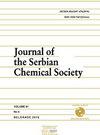Synthesis of sodium silicate crystals from rice husk ash
IF 0.7
4区 化学
Q4 CHEMISTRY, MULTIDISCIPLINARY
引用次数: 0
Abstract
The rich husk is an agricultural waste of rice cultivation worldwide, which is highly rich in amorphous silica. Rice husk obtained from Dagiri was pyrolysed at 750 ? to give white ash (RHA) which was further treated with acid (ARHA). The ash was reacted with sodium hydroxide at 90 ? for 2 hours 30 min to produce Sodium silicate crystals. Sodium silicates synthesized in the study were characterized with some physicochemical parameters. Their structural and morphological properties were assessed using a Fourier Transform Infra-red spectrophotometer (FTIR), X-ray Diffractometer (XRD) and Scanning Electrode Microscope (SEM). The mineralogical composition of the ash and sodium silicate was investigated with Energy-dispersive X-ray fluorescence (EDXRF) spectrometer. The sodium silicate produced has a melting point of 61 ?, a pH of 12.03 and appeared as brownish-white to clear-white in colour. The RHA and ARHA from XRD investigation showed patterns which match the mineral phase cristobalite, while that of the sodium silicate XRD patterns match the mineral heptahydrate disodiumtrioxosilicate as the most dominant phase. Rietveld refinement of the XRD pattern for the sodium silicate gave Rwp = 12.81, Rexp = 5.55, ?2 = 5.3274 and GoF = 2.3081 against a dual phase analysis. The sodium crystal-synthesized is suitable for use in cosmetic formulations.稻壳灰合成水玻璃晶体
稻壳是世界范围内水稻种植的农业废弃物,富含无定形二氧化硅。从Dagiri获得的稻壳在750 ?得到白灰(RHA),再用酸(ARHA)处理。灰与氢氧化钠在90度下反应?2小时30分钟生成硅酸钠晶体。用理化参数对合成的硅酸钠进行了表征。利用傅里叶变换红外分光光度计(FTIR)、x射线衍射仪(XRD)和扫描电极显微镜(SEM)对其结构和形态进行了表征。用能量色散x射线荧光(EDXRF)光谱仪研究了灰分和水玻璃的矿物组成。所制得的硅酸钠熔点为61°,pH值为12.03,呈棕白色至纯白色。XRD的RHA和ARHA图与方石英相相匹配,而水玻璃的XRD图与七水二钠三氧化硅酸相相匹配。对水玻璃的XRD谱图进行Rietveld细化,得到双相Rwp = 12.81, Rexp = 5.55, ?2 = 5.3274, GoF = 2.3081。所合成的钠晶体适用于化妆品配方。
本文章由计算机程序翻译,如有差异,请以英文原文为准。
求助全文
约1分钟内获得全文
求助全文
来源期刊
CiteScore
1.80
自引率
0.00%
发文量
76
审稿时长
1 months
期刊介绍:
The Journal of the Serbian Chemical Society -JSCS (formerly Glasnik Hemijskog društva Beograd) publishes articles original papers that have not been published previously, from the fields of fundamental and applied chemistry:
Theoretical Chemistry, Organic Chemistry, Biochemistry and Biotechnology, Food Chemistry, Technology and Engineering, Inorganic Chemistry, Polymers, Analytical Chemistry, Physical Chemistry, Spectroscopy, Electrochemistry, Thermodynamics, Chemical Engineering, Textile Engineering, Materials, Ceramics, Metallurgy, Geochemistry, Environmental Chemistry, History of and Education in Chemistry.

 求助内容:
求助内容: 应助结果提醒方式:
应助结果提醒方式:


